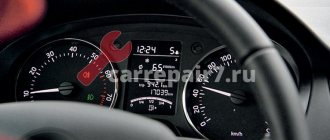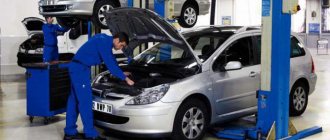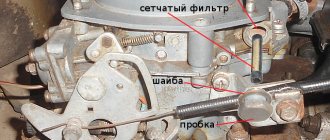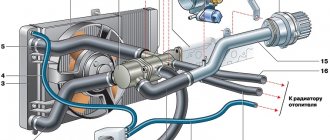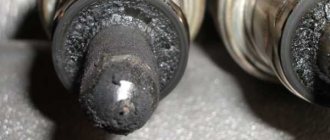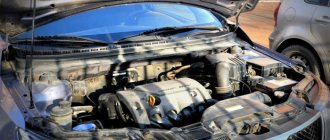Most car enthusiasts are faced with the problem of engine jolts during smooth or sudden acceleration. This problem is not critical and can be easily repaired. Moreover, users of both domestic VAZ 2112 with a 16-cl unit and owners of foreign cars such as Hyundai Solaris are not insured against this. If the car jerks when you press the gas pedal, you need to investigate such units.
- Fuel supply. As a rule, problems with acceleration begin after refueling at a questionable gas station.
- Air in the system. Excess oxygen may also leak through cracks or leaky clamps.
- Ignition. This topic is worthy of a separate issue.
- Pressure lines. Fuel pumps, ramps, injectors, filter inserts are units that require increased attention.
So, you need to figure out what to do when the car starts to jerk during acceleration.
The reason for the car “jerking” when you press the gas pedal
There are several obvious causes of jerking and increased vibration of the car during driving and acceleration. The exact diagnosis and cost of fixing the problem depends on the specific case and its neglect.
Car jerking due to TPS
The throttle position sensor is a pressing problem in modern engines with high mileage. Sensitive electronics may transmit incorrect data to the ECU or fail completely. Additionally, the valve may become clogged. Troubleshooting occurs by cleaning the remote control and diagnosing the sensor. The sensor is replaced with a known good one.
Car jerking due to mass air flow sensor
A similar problem occurs when the mass air flow sensor fails. The device is located behind the filter or in front of the throttle. The sensor is responsible for reading the amount of air consumed and transmitting the impulse to the electronic control unit.
If the system is damaged or worn out, an incorrect signal is transmitted to the head electronics - the indicators jump. Consequently, the “brains” of the car try to balance the speed of the power plant, constantly adjusting the fuel supply. As a result, this leads to the car jerking.
The problem can be fixed simply - the damaged sensor is replaced and errors are reset to the computer.
Car jerking - malfunction in the carburetor chamber and pump
A pressing problem for classic engines. The outdated design of carburetors is sensitive to low-quality fuel. Dirt and debris entering the system can disrupt the operation of the jets and float chamber. To repair the unit, it is enough to rinse it with clean fuel and blow out the passage channels with compressed air.
In classic engines, the problem of overheating of the fuel pump is not uncommon. In particular, the problem often appears on VAZ 2101-07 models. The original pump can heat up, which causes the formation of gas bubbles and interferes with the normal flow of fuel. Motorists change pumps and install structures of a different type instead.
Engine jerking due to problems with the ignition system
Improper ignition operation can cause the car to malfunction. In 90% of cases, the cause is the failure of the spark plugs to produce a spark. The bottom line is this: the fuel in the chamber does not burn as expected. Power drops and problems with the stability of the power plant appear. When the ignition in a car malfunctions, a clear symptom is engine trouble. The failure of one or more cylinders makes the entire installation tremble.
The problem is easily removed. Starting from the spark plugs, you should check the line and find the failed element.
Malfunction of fuel system sensors
Sensors for fuel consumption, pressure inside the line, fuel remaining in the gas tank, and throttle position, together or individually, can disrupt the stability of engine operation.
If the cause cannot be found, perhaps the root of the breakdown is located here.
Problems in the fuel supply system
On modern cars, failures caused by clogged injectors are a common problem. Due to low-quality fuel or faulty filters, dirt can clog thin pressure lines and bypass valves. A similar problem occurs in diesel engines.
To diagnose and eliminate car jerking, you should contact a qualified technician. It is strictly not recommended to “climb” into the fuel rail or injectors without sufficient experience.
Malfunction in the mixture preparation unit
The stability of the machine is also affected by the correct operation of the mixture preparation chamber. If the device is not calibrated correctly, the engine speed jumps, the car jerks.
The source of the problem can be eliminated by reconfiguring the system and periodically cleaning it.
We are looking for an electrical reason
This “headache” is relevant for most motorists who own outdated foreign cars with high mileage. Outdated car brains often become unstable, work intermittently, and can generate incorrect signals to control equipment.
Control units can disrupt the stability of the ignition system, fuel and air supply.
The car jerks when driving when changing gears - check the gearbox
If you have a car equipped with an automatic transmission (whether it is a standard automatic transmission, a CVT or a robot), most likely, this module is the reason why the car jerks while driving. Any problems that arise when shifting gears are related to the operation of the box, but this cannot always be determined. Especially great difficulties arise when using a CVT variator - a continuously variable transmission.
The most common problems with car jerking when switching occurred with German tiptronics installed on many models in 2002-2007. If you find problems with the car jerking when automatically shifting on a standard automatic, robot or tiptronic, perform the following test procedures:
- increase the acceleration dynamics and try to notice whether the car jerks when switching to the last gear;
- switch the transmission control mode to manual mode and check if the twitching disappears;
- check whether the symptom continues when shifting to lower gears;
- Drive for a few minutes in one gear (not the last one) and note the symptoms.
If the car twitches during any switching options, it means that the gearbox is definitely involved in this problem. In some cars, repairing a high-tech automatic transmission turns out to be too expensive, sometimes an aggregate replacement can be cheaper.
If you have a CVT installed on your car, it is impossible to determine its involvement in unpleasant manifestations. You will have to go for diagnostics and clarify the reasons for this behavior of the car. In this case, it is better to choose an official service station with branded equipment. Otherwise, the diagnostics may not be of sufficient quality, you will be told to replace the working units, and you will have to spend a lot of money on unnecessary repairs.
Causes of overclocking failure
The next common problem with some engines is poor acceleration. The problem is relevant regardless of the type of internal combustion engine and the type of fuel consumed. What makes the situation easier is that motors that differ in design have their own unique and common disadvantages. Similar traits can be described together.
- The spark plugs do not fire correctly or the high-voltage wires are broken. To eliminate the failure, you need to check everything, right down to the coils. If the nodes are working normally, you need to move on.
- Filters are clogged. A common problem for all engines is clogging of the fuel supply and air lines. Obstacles may cause problems with dynamics.
- The ignition is set incorrectly - this can also cause jerks during acceleration.
Injector
Node problems:
- Decrease in fuel pump efficiency. Similar to the principle of diesel engines, gasoline is pumped into the ramp by an injection pump. If the performance of the device is not enough, a negative effect appears.
- The injectors are clogged. Fuel nozzles have a small outlet. If even a grain of sand gets in, the throughput is sharply reduced. As a consequence, the ensuing trouble.
- Problems with MRV and PDZ sensors. Worn out or damaged sensors transmit information to the “brains” late or completely incorrectly.
- ECU. The presence of errors or software glitches inside the device provokes such breakdowns.
Carburetor
It's a little easier with a knot.
- Damage inside the float chamber. A common cause is incorrect float setting. The chamber is responsible for maintaining a minimum fuel reserve for rapid acceleration. If its regulator is set incorrectly, the capacity is not fully filled and a failure occurs during acceleration.
- Throttle cable stretch. Some classic owners have a slightly loose gas pedal, therefore the response from the carburetor will not be quick.
- The fuel pump is not working. Low efficiency of the pump or its wear also directly affects the dynamics of the car.
Diesel
- The injection pump is damaged or clogged. Conventional diagnostics of the node helps correct the situation.
- The injectors are worn out or clogged. The problem is eliminated by diagnostics on the stand.
The car jerks on the gas
It happens that a car with installed HBO jerks at idle or during acceleration. At the same time, car enthusiasts often look towards gas. However, the problem is not always hidden here.
Idling
Gases have slightly different combustion parameters and working mixture proportions. In some cases, it is enough to calibrate the mixer and everything will fall into place.
The problem is not with HBO
In most cases, when pulling a car, HBO is not relevant. Problems encountered on a conventional carburetor or injector are relevant here.
Note! According to statistics, in 8 out of 10 cases the gas installation has nothing to do with the problem.
The problem is in HBO
If the reason lies in the gas installation, it should be looked for in air sucking into the system.
- At connecting pipes or highway joints. To find the problem, just treat all “suspicious” areas with a soap solution and see where the bubbles swell.
- Damage to the hoses themselves. Hoses can crack due to time and constant overheating.
- Suction through the installation site of the fitting (cotton). Here it is enough to tighten the connection.
- Cracking of the gearbox gasket. The part is often exposed to critical temperature changes, which can lead to its failure.
Incorrect operation of the ignition system
The ignition system also causes unstable engine behavior due to:
- spark plugs - the fault is easily determined by the color of the deposit and the size of the contact gap;
- high-voltage wires - it is recommended to check with a megger;
- coils - visually inspected for cracks and current leakage.
It is advisable to check spark plugs with a special spark plug. It will allow you to correctly determine the gap between the electrodes, which is normally 1-1.3 mm (on carburetor cars - 0.7-0.8 mm). Increasing this value leads to damage to various ignition system devices. Any known-good spark plugs are also used as a tester.
The coil is also checked for spark. Diagnostics will require a spark plug wrench and pliers. During the test, the ignition must be turned off. Then any armored wire is removed and connected to a known working free spark plug. Next, the engine is started and the spark that appears between the electrodes of the spark plug is examined. Its color should be bright purple.
Poor engine performance is often caused by a short circuit or open circuit in the low voltage circuit. Incorrect connection of the wires to the spark plugs also significantly reduces the performance of the internal combustion engine, causing interruptions.
Diagnostics
The diagnostic procedure for different engine designs is performed according to a different algorithm.
However, there are general faults. During the process, it is necessary to check the fuel system, air supply lines, and ignition apparatus. In this case, troubleshooting is performed one by one for all units. If the sequence gives a result, the damaged node is replaced with a known good one (new).
In what cases is a car “jerking” detected?
Most cases of car “jerking” are associated with problems with wear of spare parts or clogging of one of the car’s systems. While driving, you can detect vehicle twitching at the following stages:
- When starting only at the beginning of the car's movement;
- When driving at low speeds;
- During a sudden increase in speed;
- When driving at high speed;
- When driving in any mode (periodic shocks at different periods of time).
Consider the case of a vehicle malfunction when driving at low speeds.
What to do
If you lack knowledge or lack confidence in your own abilities, you can seek help from a service station, where specialists will conduct a diagnostic examination and repair the car.
If the user decides to figure it out on his own, he must do the following.
When I press on the gas, the car jerks and does not move.
In the case when the car behaves predictably at idle, and when the trigger is pressed, jerks are felt, and the car slowly picks up speed. The problem lies in the lean or over-enriched mixture entering the cylinders. It doesn’t matter whether it’s an old VAZ or a new modification like the Hyundai Accent. The original source is located here.
The secondary question is how this happens, because in 50% of cases the carburetor or injector is configured correctly.
The car jerks when accelerating and pressing the gas sharply
Similar symptoms occur on fuel-injected foreign cars - when the trigger is pressed firmly, the car jerks. In this case, acceleration occurs in normal mode. For cars such as Ford Focus, Opel Astra J, Chevrolet Cruze, the problem may be a breakdown of the ECU, mass air flow sensor, or TPS. The problem also does not avoid modifications of the VAZ 2114 and Audi A6 C5. The easiest way to diagnose is to replace parts with obviously new ones. Thus, the throttle position sensor may become “stupid”, incorrectly indicating to the ECU the location of this unit, which causes variable throttle opening with all the ensuing consequences. Also, the mass air flow sensor may incorrectly interpret the indicators, which will cause the mixture to become leaner.
When you press the gas pedal, the car stalls, then jerks sharply
When a vehicle stalls during acceleration, followed by a sharp jerk, and then the dynamics stabilize. The following items need to be checked:
- air line;
- accelerator pump;
- fuel quality;
- checkpoint;
- main fuel pump;
- ignition settings;
- MRV sensor.
Owners of the Lada Priora periodically face the problem of fuel pump failure. Here it will be enough to replace the element with a new one, to be on the safe side, clean the lines (low-quality fuel could get in).
Also, in some cases, the engine begins to stall and then accelerate. Here, the mass air flow sensor is checked, the spark plugs are diagnosed, the ignition angle is checked, and the injectors are clogged.
Additionally, if you have an automatic transmission, you need to check this mechanism. About 20% of visits to a car service center with similar faults end in “treating a surprise” inside the torque converter.
The car jerks while driving when the gas pedal is pressed lightly
A more exotic malfunction is when, when you smoothly press the trigger, the car begins to twitch until the power plant reaches a certain speed. There is a lack of combustible mixture in the float chamber of the internal combustion engine - gasoline burns faster than it can flow. This is a side effect of a faulty fuel pump; the unit does not have time to pump a new portion of the mixture, which provokes engine jolts.
Note! On independent designs like the carburetor Oka or the injection Lanos, the breakdown in 90% of cases manifests itself in the same way, which narrows the search area.
The car jerks when you press and release the gas
If, when the speed is reduced, the car begins to nod, and during acceleration it jerks again, there may be two sources of the problem.
- Sensor failure. Faulty sensors send incorrect data to the ECU, causing a disruption in the uninterrupted fuel supply.
- Clogged dosing elements (nozzles, jets). Owners of classic models such as the VAZ 2107 often encounter a similar problem. A clogged injector, after releasing the gas, “spits out” part of the fuel, which causes an increase in speed. During sudden acceleration, the element does not have time to supply the required amount of mixture to the cylinder.
Carburetor car jerks when you press the gas
If a problem is detected on carburetor vehicles such as VAZ 2109/2106. First of all, you need to pay attention to the fuel supply system . The design of standard Solex carburetors has outlet tubes designed to supply gasoline to the mixture formation chamber. By pouring low-grade fuel, thin channels can become clogged, which prevents its free passage. Usually the channel of the first chamber is clogged. If the engine jerks while gaining speed, and after reaching 2500-3000 rpm the acceleration proceeds smoothly - this is where the trouble lies. The defect is eliminated by purging the unit with compressed air and preliminary cleaning the jets (just in case).
It is also necessary to check the main pump (a problem with all classics), and the ignition timing.
When you press the gas, a car with an injection engine jerks
If the injection VAZ 2110 twitches, the search for the problem should start from the MVR, PDZ, and ECU sensors.
In this case, faulty sensors can send a false signal to the control unit, which is the primary source of the trouble. The next reason is clogged injectors. Symptoms usually appear 15-20 km after filling low-quality fuel into an empty tank.
The last point is failure, ignition interruptions. Spark plugs and armored wires are diagnosed.
Diesel car jerks when pressing gas
Regarding diesel engines, the solution to the problem is extremely simple - jamming of the moving blades of the main pump. The reason for this phenomenon is considered to be long-term downtime of transport in a damp place. It is moisture that oxidizes metal surfaces, which leads to jamming of the structure.
Failure repair is carried out by replacing the damaged part.
Transmission breakdowns
Engine malfunction may be caused by damage to the transmission. Most often, the clutch wears out or the grenades break. Less often, the gearbox and its mounting components, including the supports and brackets of the power unit, fail.
The most difficult thing to determine is the failure of the gearbox and clutch - they have to be dismantled and disassembled. It is much easier to diagnose the condition of the airbags and CV joints by using a lift or inspection hole. To check their mobility, the hinges are pumped in different directions. Breaks in motor supports are detected as follows: take a long crowbar and lift the motor (box) near the attachment points. Damage is immediately noticeable.
Clogged or faulty injectors
During prolonged operation of an injection engine, varnish and resin deposits from fine particles and heavy fractions of sulfur, hydrocarbons, and ethylene accumulate on the injectors. They greatly slow down the operation of the injection system, change the direction and shape of the spray, and in some cases completely shut off the fuel supply. Obviously, in such a situation, the formation of fuel worsens, the tightness of the regulators is broken, and the overall performance of the internal combustion engine decreases. Therefore, the car moves jerkily and twitches.
Replacing injectors according to manufacturers' recommendations should be done every 120–150 thousand kilometers. But it’s much more important and important to clean them. This must be done at least every 30 thousand mileage, especially in Russian road conditions.
Popular brands:
Kia Sportage
Clogged air and fuel filters
On cars of recent years of production, several fuel filters are used. Their main task is to capture large and small deposits and impurities - the power system and internal combustion engine do not tolerate dirty fuel well. There are fine and coarse cleaning elements - the latter are a mesh and are located inside the fuel pump. The filter life is limited - they last 15–30 thousand kilometers. The mesh can last up to 100 thousand km. The main sign of blockage is jerking and jerking of the vehicle. At the same time, other disadvantages arise:
- fuel consumption increases;
- The power of the power unit decreases - acceleration deteriorates;
- The motor stops spontaneously at idle or while moving.
A dirty fuel filter is replaced, or less often cleaned.
Almost the same thing happens with a dirty air filter. The car jerks even more intensely, and engine detonation increases. Then the spark plugs fail, and all the electrics begin to “go crazy”, showing various warnings such as Check Engine on the display. A new filter costs about 200–300 rubles, so it is advisable to replace it frequently - every 10 thousand kilometers.
Bad fuel
Today, fuel is spoiled not only by water, but also by various unknown additives. This fuel contains a lot of sulfur, benzene, aromatic hydrocarbons and ethers. Therefore, all vehicle systems are subject to increased loads. First of all, the injector, ignition, and exhaust suffer. Then, due to increased detonation, the engine overheats - the pistons, rings, and cylinder walls are damaged.
If you have already poured a low-quality composition, get rid of it immediately! Empty the tank, flush the fuel system, clean the injectors and replace the spark plugs. Only after these steps, refuel with good fuel.
